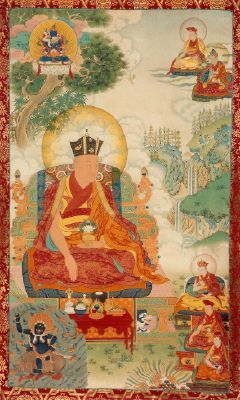Karmapa XIV - Thegchog Dorje
 THE XIVth KARMAPA
THE XIVth KARMAPA
(1798 - 1868)
The fourteenth karmapa, Thegchog Dorje was born in Salmo Gang in Kham, the village of the Danang family, in the year of the Fire Snake (1798 C.E.). During her pregnancy, his mother had had several
auspicious dreams, indicating the birth of an incarnate guru. It is recorded that, on the day of his birth, rainbows appeared and flowers bloomed, even though it was in the depths of the winter. The newborn child was heard to recite the Sanskrit alphabet.
News of the prodigy travelled quickly and a search party was dispatched by Drukchen Chokyi Nangwa to find the incarnation of his guru. This party, having reached Salmo Gang, met with two
other parties from Situ Rinpoche and Gyaltshab Rinpoche. Together they conducted the child to Ogmin monastery, where they determined that the details of his birth matched exactly those set out in the previous Karmapa's letter of prediction. The ninth Situ. Padma Nyinche Wangpo, formally recognized Thegchog Dorje as the new Karmapa. He also ordained him as a novice. For the next few years at Ogmin Ling, Thegchog Dorje studied the doctrines of the Kagyu and Nyingma traditions.
After being enthroned and receiving the vajra crown, the fourteenth Karmapa went to Tsurphu, where he continued his studies. At the age of nineteen he was ordained a monk by Situ Rinpoche and Drukchen Chokyi Nangwa. During this period he engaged in the rebuilding and repair of the monastery itself and many of the stupas and temples in the surrounding area. Thegchog Dorje was himself highly expert in various arts and crafts, including sculpture and metal work.
The fourteenth Karmapa was an accomplished scholar and linguist. He devoted much of his time to poetry and was especially skilled in rhetoric and poetics. During his lifetime there occurred the great Buddhist renaissance in Tibet, due largely to the Rime movement. This movement, which originated in Kham, was led by many teachers from the various traditions such as Jamgon Kongtrul Lodro Thaye, Khyentse Wangpo and Terton Chogyur Lingpa. It was not an attempt to form a new school or organization, but rather it sought to bring together and make available the richness of each tradition to everybody. Those involved in the movement were not just religious scholars and meditators, but were also talented artists, poets, doctors and even scientists, as was Mipham Rinpoche.
Thegchog Dorje both influenced and was himself influenced by this trend. He gave lineage teachings to Jamgon Kongtrul and Jamyang Khyentse Wangpo as well as certain specific teachings to the former. From the great terton, Chogyur Lingpa, he received the great sadhana of Vajrakilaya.
Subsequently he instituted the yearly performance of this ritual, alternating with the Tsechu dance ritual of Padmasambhava, at Tsurphu.
The fourteenth Karmapa was renowned for his personal austerity and his strictness as a monk. Although he was himself the embodiment of compassion, Thegchog Dorje demanded complete observance of the monastic rules from those around him.
In the 1860s Karmapa travelled throughout Kham, working continually for the the benefit of the people. He recognized and enthroned the tenth Situ, Padma Kunsang, at Palpung monastery. During his stay there he gave teachings to Kongtrul Lodro Thaye, the profound Rime scholar.
After his guru had returned to Tsurphu, Kongtrul Lodro Thaye followed to continue studying with him. Shortly before Karmapa’s death Lodro Thaye received the transmission of the lineage from him.
Thegchog Dorje passed away in 1868 at the age of seventy. His principal students were Kongtrul Lodro Thaye, Drukchen Mipham Chokyi Gyatsho, Dechen Chogyur Lingpa, Pawo Tsuglak Nyingche and Jamyang Khyentse Wangpo.
Reproduced with permission of the Very Venerable Karma Thrinley Rinpoche.



